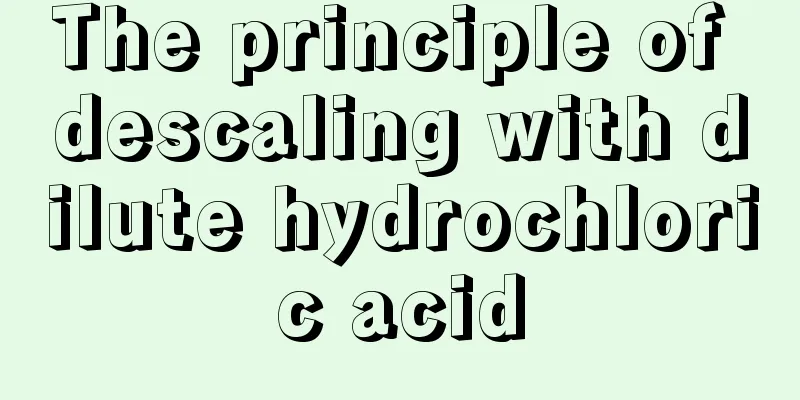The principle of descaling with dilute hydrochloric acid

|
In our daily life, there will be some scale in kettles and water pipes. These are caused by the rust in the water. When this happens, we need to solve it in time, because if it is not cleared for a long time, it will become more and more difficult to remove in the future. Today we will introduce to you the principle of descaling with dilute hydrochloric acid. Let’s take a look together below. Water containing minerals such as calcium (Ca) and magnesium (Mg) salts is called "hard water". River water, lake water, well water and spring water are all hard water. Tap water is river water, lake water or well water that has been sedimented, silt removed, and disinfected and sterilized. It is also hard water. The water from fresh rain or snow does not contain minerals and is “soft water”. After the water boils, part of the water evaporates, and the calcium sulfate (CaSO4, gypsum is calcium sulfate containing water of crystallization) that is originally insoluble precipitates. The originally dissolved calcium bicarbonate (Ca(HCO3)2) and magnesium bicarbonate (Mg(HCO3)2) decompose in boiling water, releasing carbon dioxide (CO2), and turning into insoluble calcium carbonate (CaCO3) and magnesium hydroxide (Mg(OH)2) which also precipitate. This is where scale comes from. When washing clothes with hard water, the calcium and magnesium ions in the water combine with soap to form flocculent precipitates of fatty acid calcium and fatty acid magnesium. This is the origin of "tofu dregs". Washing clothes in hard water wastes soap. Descaling in chemistry Scale ingredients: calcium carbonate (CaCO3), magnesium hydroxide (Mg(OH)2), magnesium carbonate (MgCO3), calcium sulfate (CaSO4), barium sulfate (BaSO4), silicon dioxide (SiO2), iron (Fe2O3 & Fe3O4) Cause of scale: Ca(HCO3)2 and Mg(HCO3)2 decompose in boiling water to release CO2. Descaling chemicals: Dilute hydrochloric acid (HCl) is commonly used, and sometimes vinegar can be used. Principle: Hydrochloric acid reacts with insoluble CaCO3 and Mg(OH)2 to form soluble salts. 2HCl+CaCO3=CaCl2+H2O+CO2↑(same chemical equation as the one used to make CO2 in the laboratory) 2HCl+Mg(OH)2=MgCl2+2H2O Note: Do not soak in acid for too long, otherwise it will react with the metal material of the kettle and damage the kettle. After descaling, rinse with water immediately and wipe with a dry cloth. The above is the principle of descaling with dilute hydrochloric acid introduced to us by professionals. If there is scale in household appliances at home, we can refer to the descaling method mentioned above, so that we can easily remove the scale without having to worry about it. I hope the above content can help everyone. |
<<: What is the significance of central venous pressure
>>: What are the methods for removing scale
Recommend
What are the early symptoms of breast cancer? Pay more attention to these 5 symptoms of breast cancer
Female breast cancer is a "health killer&quo...
How many days can wolfberry be soaked in water?
Lycium barbarum is not only a common Chinese medi...
How long can you live with mid-stage skin cancer
Many patients worry about how long they can live ...
Why do my legs suddenly hurt?
Leg pain is a common phenomenon in life. Most peo...
Use the sprinkler to spray below
The health of women's body is very important,...
What is the reason why drinking water makes you fat?
Perhaps everyone has heard such a sentence: "...
Treatment of surgical complications in patients with gastric cancer
The management of surgical complications in patie...
The most important early symptoms of nasopharyngeal cancer
Among the many cancer diseases, nasopharyngeal ca...
How to make an wormwood pillow?
In life, mugwort has many uses. In the future, yo...
Teratoma should be comprehensively prevented and treated
The treatment of teratoma is difficult, and now p...
What to do if braces are loose
Various situations will be encountered during the...
Eight wonderful uses for expired tea leaves
Many people have the habit of drinking tea. Drink...
Early manifestations of rectal cancer in women
The early manifestations of rectal cancer in wome...
The "devil's moment" when people lose their lives
Scientific research shows that the occurrence and...
The surgical treatment of brain cancer is like this
In recent years, brain cancer has gradually risen...









